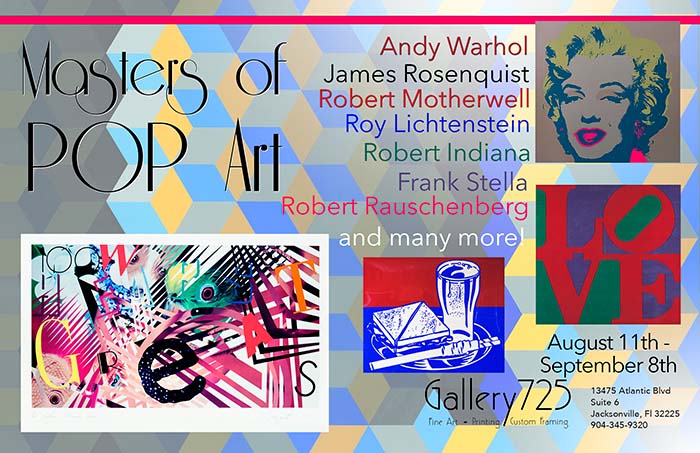AUGUST 11TH – SEPTEMBER 8TH
“Pop is everything art hasn’t been for the last two decades [referencing Abstract Expressionism]. It’s basically a U-turn back to a representational visual communication, moving at a break-away speed…Pop is a re-enlistment in the world… It is the American Dream, optimistic, generous and naïve.” Jim Dine
Pop art, art movement of the late 1950s and ’60s that was inspired by commercial and popular culture. Although it did not have a specific style or attitude, Pop art was defined as a diverse response to the postwar era’s commodity-driven values, often using commonplace objects (such as comic strips, soup cans, road signs, and hamburgers) as subject matter or as part of the work.
Pop Art was nothing more than the art world’s response to the rise of entertainment. Television, games, spending money… there were so many ways to pass the time in this new society. Art faced fierce competition and it reacted by imitating the conventions of popular culture.
Although Pop Art was based on the same principles in the United States and Great Britain, there were a few differences. British Pop Art followed the developments in American society but viewed them with more distance, humor, and emotion. American Pop Art directly soaked up the culture of entertainment, the media, and consumerism; it was therefore the immediate result of that experience. American art was more aggressive, and its aesthetic and stylistic traits were more defined.
Uniqueness was abandoned and replaced by mass production. In addition to using elements of popular culture, Pop Art artists replicated these images many times, in different colors and different sizes… something never before seen in the history of art. As a matter of fact, these artists were often criticized, and for good reason; such artworks were no longer truly the work of the artist, they lost their “artisan” character.
Pop Art is an artistic movement, of course, but it is much more than that. It is an entire generation that made cynical observations about society, with style and humor. However, “fine” art was only the sounding board for these observations because, at the time, many fields drew inspiration from Pop Art. The rock group “Velvet Underground”, for example, asked Andy Warhol to design their album covers.
It is this casual and critical attitude that makes Pop Art “irreproachable,” because ultimately it only comments on changes in society while also taking responsibility for them.
Pop art found critical acceptance as a form of art suited to the highly technological, mass-media-oriented society of Western countries. Although the public did not initially take it seriously, by the end of the 20th century it had become one of the most recognized art movements.




